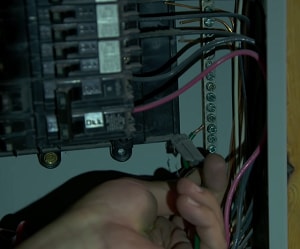A generator can provide electricity to connected appliances and other electronics. But you also need to learn how to distribute that power efficiently with a transfer switch. Now you’re wondering, how to use a generator transfer switch?
Make a transfer switch work by installing this module correctly. Once it’s set up, turn on the generator before turning on the circuits on the transfer switch and service panel.
Keep in mind that to connect a generator transfer switch to a home’s electrical wiring, you need to be careful. Continue reading to learn the details of this job so you won’t be at a high risk of making expensive mistakes.
Using a generator transfer switch usually doesn’t require any special tools. But to use a transfer switch also means learning how to install it properly.
In this guide, you’ll find the tools and steps to hook up a generator transfer switch and use it correctly.
Table of Contents
What to Prepare
- Transfer switch: Generators may or may not have a transfer switch. Take note that you may use a DIY generator transfer switch or buy it from a trustworthy retailer.
- Screwdriver: Generally used in this operation to remove an area of the main electrical service panel box. You may use it for a circuit breaker installation if needed.
- Hammer: Used in conjunction with the screwdriver to open a knockout panel in the main service panel box.
- Wrench: To secure the wires connecting the transfer switch to the circuit breakers in the electrical service panel.
Step-by-Step Guide
Step #1: Install The Home Generator Transfer Switch
- First, consult your home’s wiring diagram to ensure the transfer switch’s install location is correct. Also, ensure that the module is near the service panel.
- You may install a generator transfer switch inside or outside of your home. Evaluate your property’s electricity needs to ensure you have the correct location.
- Before setting up the transfer switch for generator, open the service panel and turn off the main breaker.
- Then, label the circuits you use in your home that are needed for emergency use. For example, place a sticky note on the circuit breaker connected to the furnace or refrigerator.
- Take note of the load of each circuit you’ll use to connect to the transfer switch. Balance the load transference as best as you can to prevent overloading the generator.
- Grab your hammer and screwdriver, and use those tools to remove a knockout hole at the bottom of the main service panel.
- The next step is to feed the wires from the transfer switch through the knockout hole and into the service panel. Do this step carefully or risk damaging the wires’ insulation.
- Put a locknut on the group of wires until it rests on the inner portion of the knockout hole. Secure the locknut with a wrench afterward.
Step #2: Connect the wires from the transfer switch to the labeled circuit breakers.
- The red wire goes into the breaker (whose hot wire should be taken out).
- Twist the black wire and the feed wire together.
- The neutral wire should connect to the panel’s neutral bus bar. Similarly, the ground wire goes to the grounding bar.
You may need to check your home’s wiring illustration frequently for this step.
Step #3: Connecting generator to transfer switch
You can use the generator cord for this.
Step #4: Use Manual Transfer Switch
With the module installed correctly, use a transfer switch by first turning off all the circuit breakers in the main service panel. Then, turn on the connected generator.
Allow the generator to warm up for a few minutes.
Next, open the electrical service panel. Turn on the circuit breakers connected to the transfer switch one at a time (making sure they’re on generator mode).
Don’t forget to turn off the circuit breakers in the service panel before switching the circuits on the transfer switch to utility power when the power returns.
Conclusion
Remember that a proper initial setup procedure is necessary for you to know how to use a generator transfer switch correctly. Make sure to follow the step-by-step process highlighted in this post.
Also, don’t be hasty when you turn the circuits on or off. Activate or deactivate these power deliverance units one at a time. Otherwise, you might overload the generator, which may lead to irreparable harm to the system.

I am Andrew Wright. With 8 years of experience designing, installing, and maintaining electrical power systems. I love my job, and I have always wanted to offer others the necessary help so they can take care of their houses.





